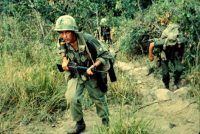A Frontline Nurse for the Vietcong
For many in Vietnam, memories of what took place remain vivid. I recently visited Nguyen Thi Do, a former nurse with the National Liberation Front, also known as the Vietcong. After 10 years of wartime service, Ms. Do moved to Qui Nhon, a beachfront city in her home province on Vietnam’s Central Coast, where she helped administer a fishing company until retiring in 1989. She invited me into her living room with its stylish wooden furnishings, poured two cups of green tea, and shared her story.
When I was 17, National Liberation Front recruiters came to my village, Lo Dieu in the Hoai Nhon District of Binh Dinh Province.… Seguir leyendo »


















